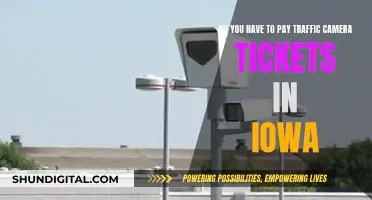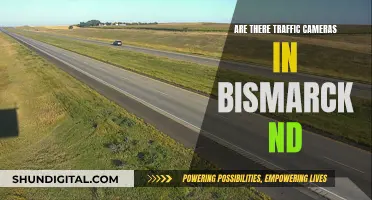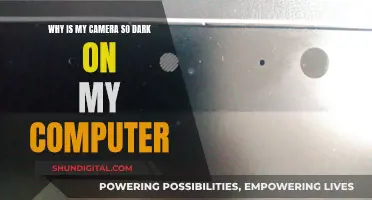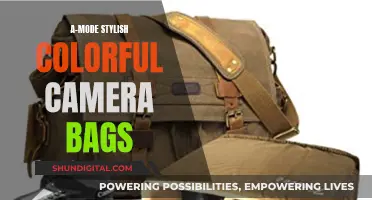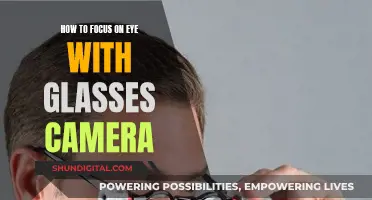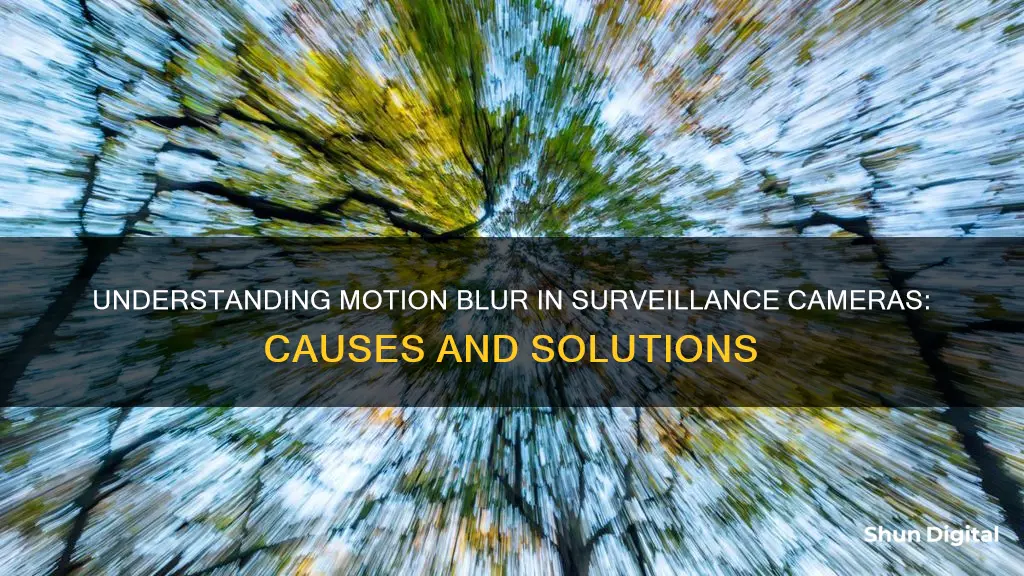
Motion blur is a common issue in surveillance cameras, causing blurry and unclear images that can hinder accurate identification of subjects. This phenomenon occurs when a moving object changes location during the exposure time, resulting in the light from the object appearing in multiple areas of the image, leading to blurring. The faster the shutter speed, the less motion blur is produced, but this also results in darker images. Conversely, longer exposure times allow more light to be captured, creating brighter images but increasing the likelihood of motion blur. The challenge lies in finding the right balance between exposure time and shutter speed to ensure clear and well-lit footage.
| Characteristics | Values |
|---|---|
| Cause of motion blur | Movement or vibration during the exposure time of the camera |
| Change of location of a moving object | |
| High exposure time | |
| Low shutter speed | |
| Solution | Reduce exposure time |
| Increase shutter speed | |
| Use a lens with a bigger aperture | |
| Use a camera with a big pixel size | |
| Use camera in binning mode | |
| Use a Monochrome camera | |
| Add digital gain | |
| Add extra external lights | |
| Slow down the movement of the object |

Shutter speed
Motion blur is caused by the movement of an object during the exposure time of a camera. This results in unsharp or blurry images, which can be a problem for surveillance cameras, as it can make it difficult to identify subjects in the footage. To avoid motion blur, the shutter speed must be fast enough to freeze the scene and prevent motion blur.
The shutter speed required to avoid motion blur will depend on the speed of the objects being captured. For example, a surveillance camera monitoring a busy street with fast-moving traffic will require a faster shutter speed than one monitoring a car park with slowly moving vehicles.
It's important to note that increasing the shutter speed will result in a darker image, as there is less time to capture light. To compensate for this, you can use a lens with a larger aperture, which will allow more light to reach the sensor, or increase the ISO (light sensitivity) of the camera. However, increasing the ISO can also introduce noise to the image, so it's important to find the right balance between shutter speed and ISO for the specific surveillance environment.
In addition to adjusting shutter speed and ISO, there are other techniques that can be used to reduce motion blur in surveillance cameras. One technique is to use a high-speed exposure camera, which can capture images with very short exposure times, reducing the likelihood of motion blur. Another technique is to use a global shutter camera, which captures the entire scene at once, rather than using a rolling shutter, which captures the scene line by line. This can help to reduce the distortion caused by motion blur.
Charging the Eufy 2C: Know When It's Ready
You may want to see also

Exposure time
Motion blur is caused by the movement of an object during the exposure time of a camera. The exposure time, or the duration for which a camera's image sensor is exposed to light, plays a crucial role in determining the amount of motion blur in a captured image.
The exposure time defines how much light a camera will process before generating an image. A longer exposure time allows the camera to collect more light, resulting in a brighter image with less noise. However, during a long exposure, moving objects can create motion blur as they change location, causing their light to be present in multiple areas of the image. This effect is more pronounced when objects move faster or when the exposure time is longer.
To reduce motion blur, the exposure time can be decreased. This reduces the amount of light captured, resulting in a darker image. However, a shorter exposure time freezes the scene, preventing motion blur by limiting the distance an object can move during the image capture.
The trade-off between exposure time, motion blur, and image brightness presents a challenge for surveillance cameras, especially in low-light conditions. Surveillance cameras need to balance the requirement for minimal motion blur with the need to operate in low-light environments, which often necessitates longer exposure times.
In addition to adjusting exposure time, other techniques can be employed to reduce motion blur. These include using cameras with larger pixel sizes, which capture more light, or employing post-processing techniques, although these may introduce issues such as image noise.
Charging Nixon Camera Batteries: A Step-by-Step Guide
You may want to see also

Light conditions
In low-light conditions, surveillance cameras require a longer exposure time to capture sufficient light for an image. During this extended exposure, moving objects are more likely to cause motion blur as they change their position within the frame. This results in the light from the object appearing in multiple areas of the image, creating a blurred effect.
Conversely, in well-lit conditions, shorter exposure times can be used, reducing the likelihood of motion blur. However, shorter exposure times can also result in darker images, especially in low-light environments. To compensate for this, additional lighting can be introduced to the scene, allowing for shorter exposure times without sacrificing image brightness.
The speed of the objects being captured also influences the occurrence of motion blur. Faster-moving objects are more likely to cause motion blur, even with shorter exposure times. Adjusting the shutter speed can help mitigate this issue, as a higher shutter speed captures a shorter duration of motion, reducing the blurring effect.
In summary, the interaction between lighting conditions, exposure time, and object speed determines the occurrence of motion blur in surveillance cameras. Adjusting these factors can help reduce motion blur and improve the clarity of captured images.
Editing Raw Camera Files: A Step-by-Step Guide
You may want to see also

Camera resolution
When it comes to motion blur, a higher-resolution camera can help reduce this issue. Motion blur occurs when an object moves during the exposure time, resulting in a blurry image. With a higher-resolution camera, the exposure time can be shorter, as it will require less light to create a well-lit image. This reduces the likelihood of motion blur, as there is less time for the object to move during the exposure.
However, a shorter exposure time can also result in a darker image, as there is less time to capture light. To compensate for this, additional lighting can be added, or a camera with larger pixel sizes can be used, allowing for more light to be captured.
It is important to note that while a higher-resolution camera can help reduce motion blur, it is not the only factor. The shutter speed, frame rate, and lighting conditions also play a significant role in determining the amount of motion blur in a surveillance image or video.
To eliminate motion blur, a high-speed exposure camera is ideal. However, this can be challenging for surveillance cameras that need to operate in low-light conditions, as a longer exposure time is typically required in such scenarios. Finding the right balance between exposure time and lighting conditions is crucial to achieving clear and well-lit surveillance footage.
Soft Focus Shooting with Fuji: A Guide
You may want to see also

Object speed
Motion blur is caused by the relative motion between the camera and the objects it is capturing. When an object moves too fast for the camera's exposure time, it will appear blurred in the resulting image. This is because the image represents an integration of all positions of the object over the period of exposure, rather than a single instant in time.
The faster an object moves, the more likely it is to appear blurred in a photograph. This is especially true if the object is moving faster than 0.5 pixels during the exposure time. In this case, the shutter speed is not fast enough to freeze the scene, and motion blur will occur.
To avoid motion blur caused by fast-moving objects, the shutter speed of the camera must be increased. This will freeze the motion and prevent blurring. However, a faster shutter speed will also result in a darker image, as there is less time to capture light.
The speed of an object is not the only factor that contributes to motion blur. The exposure time of the camera also plays a crucial role. A longer exposure time will result in more motion blur, even if the object is moving relatively slowly.
In some cases, photographers may actually want to create motion blur to enhance the action or convey a sense of speed. This can be achieved by using a slow shutter speed and panning the camera to track the moving object. By manipulating the camera's movement, the photographer can control whether the object or the background appears blurred.
Olympus Pen Camera Battery: Charging Time Explained
You may want to see also
Frequently asked questions
Motion blur is the apparent streaking of moving objects in a photograph or a sequence of frames, such as a film or animation.
Motion blur is caused by the movement of objects or the camera itself during the exposure time. When the object moves for more than 0.5 pixels during the exposure time, the image will exhibit motion blur.
Motion blur can be reduced by increasing the shutter speed to freeze the scene and prevent objects from moving more than 0.5 pixels during the exposure time. However, this will result in darker images as there is less time to capture light.


